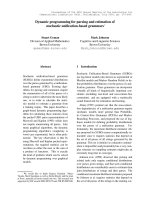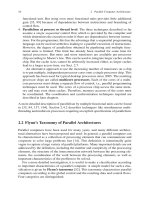Serial port programming for Windows and Linux
Bạn đang xem bản rút gọn của tài liệu. Xem và tải ngay bản đầy đủ của tài liệu tại đây (83.28 KB, 10 trang )
Serial Port Programming in Windows and Linux
Maxwell Walter
November 7, 2003
Abstract
While devices that use RS−232 and the serial port to
communicate are becoming increasingly rare, it is still
an important skill to have. Serial port programming,
at its most basic level, consists of a series of steps
regardless of the operating system that one is oper-
ating on. These steps are opening the port, configur-
ing the port, reading and writing to the port, and fi-
nally, closing the port. It is possible then to create an
API that contains the functions necessary to success-
fully communicate with the serial port. With a single
header file that contains all the functions necessary to
communicate over a serial port, the implementation
details can remain platform dependent as a library
that can then be compiled and maintained separately
for each operating system. The actual application can
then use the common header file as its interface to the
serial port. This creates a cross-platform serial inter-
face allowing the creation of code that is more easily
portable across operating systems. In this document
the functions and steps necessary to use the serial
port are detailed, and at the end of this document an
example cross-platform header file is provided.
Keywords: Serial Port, Programming, Linux, Win-
dows
1 Introduction
The advent of USB has caused a significant decline
in the number of devices that communicate using
RS−232, and many motherboards today ship with-
out serial ports. This does not mean, however, that
serial port programming is no longer a necessary or
relevant skill to posses. Many important and useful
devices still in use today date back to pre-USB times,
and there are still some devices that continue to use
the RS−232 protocol for communication. Also, be-
cause there are far fewer devices that communicate
using RS−232, fewer people are exposed to it, and
thus fewer people learn how to use it, making it an
even more valuable skill.
Serial port programming requires API’s provided
by the underlying operating system to communicate
with the hardware, making serial port programming
operating system dependent and not very portable.
However, because communicating with the serial port
itself requires few steps, a library with a common API
can be created and separate versions maintained for
different operating systems. The goal of this docu-
ment is to develop an operating system independent
class allowing the creation of portable code that uti-
lizes the serial port.
2 RS−232 Overview
The RS−232 protocol was originally designed in 1969
by the Electronic Industries Association (EIA) as a
general method of data transmission between two de-
vices. They wanted to create a specification that
would be free of transmission errors while being sim-
ple enough that it would be adopted by many de-
vice manufactures. The protocol that they developed
specified signal levels, timing, mechanical plugs, and
information control protocols. The RS−232 spec-
ification has gone through three major milestones,
namely:
• 1969: The third version of the RS−232 protocol
(originally called RS−232−C) was adopted as a
standard by the industry.
• 1987: EIA created a new version of the standard
called EIA-232-D.
• 1991: EIA and Telecommunications Industry
Association created a new version of the stan-
dard that they called EIA/TIA-232-E. Most
called the standard RS−232−C or simply
RS−232.
Other specifications have been created that aim to
remove defects inherent in the original RS−232 spec-
ification including:
• RS−422: Allows a line impedance of up to 50Ω
1
• RS−423: Minimum line impedance of 450Ω
• RS−449: High rate of communication speed us-
ing a 37 pin plug
[2] [3]
3 Serial Port Programming
There are four operations that must happen in proper
order to successfully communicate over the serial
port. These are to open the serial port, configure
the serial port, read and write bytes to and from the
serial port, and close the serial port when the task has
been completed. It is important to check the return
codes at each stage to ensure that the task has been
completed, because failure at one stage means that
the next stage will fail as well. Sanity checking the
return codes is also good coding practice, and throw-
ing away important information can lead to program
errors that are difficult to trace.
The serial port is a bi-directional port meaning that
it can send data in both directions, and, because it
has separate pins for transmit and receive, a device
can send and receive data at the same time. Sending
and receiving data at the same time is called over-
lapped communication as opposed to non-overlapped,
or blocking communication. This paper will deal
exclusively with non-overlapped communication as
overlapped communication requires very complex ob-
jects such as threads, mutexes, and semaphores.
Also, non-overlapped communication is adequate in
many situations.
The two operating systems discussed here, Win-
dows and Linux, both have simple communication
API’s that facilitate communication over the serial
port. While certain tasks, such as opening and clos-
ing the serial port, are very similar, other tasks such a
configuring the serial port are very different. It is our
goal to create a single header file that provides a con-
sistent interface across multiple operating systems,
requiring only that the programmer link against the
object library for the operating system his program
is compiling on.
3.1 Opening the Serial Port
The first step that is necessary to communicate over
the serial port is to actually open the device. Under
both Windows and Linux, the serial port is treated as
a file, so to open the serial port one calls the functions
used to open a file. There are restrictions on the
parameters allowed when opening the file however,
and those will be discussed in the appropriate section
below. The options are operating system dependent.
3.1.1 Windows
The function used to open the serial port in the Win-
dows operating system is CreateFile() which is used
as follows:
HANDLE fileHandle;
fileHandle =
CreateFile(
//the name of the port (as a string)
//eg. COM1, COM2, COM4
gszPort,
//must have read AND write access to
//port
GENERIC_READ | GENERIC_WRITE,
//sharing mode
//ports CANNOT be shared
//(hence the 0)
0,
//security attributes
//0 here means that this file handle
//cannot be inherited
0,
//The port MUST exist before-hand
//we cannot create serial ports
OPEN_EXISTING,
//Overlapped/Non-Overlapped Mode.
//This paper will deal with
//non-overlapped communication.
//To use overlapped communication
//replace 0 with
//FFILE_FLAG_OVERLAPPED
0,
//HANDLE of a template file
//which will supply attributes and
//permissions. Not used with
//port access.
0);
CreateFile() returns a HANDLE object that can then
be used to access the port. If CreateFile() fails, the
HANDLE object that is returned is invalid and va-
lidity can be tested using the following code:
if (fileHandle == INVALID_HANDLE_VALUE) {
//error handling code here
}
2
Provided that the serial port is successfully opened
the next step is to configure it to the specific appli-
cation.
3.1.2 Linux
Opening the serial port in Linux is performed in much
the same way as it is in Windows, using the open()
command. One caveat to Linux is that the user ID
that the program is running under must be allowed
to access the serial port, either by giving the user
permission to the serial port, or by changing the per-
missions of the program to allow access to the serial
port. Code to open the serial port under Linux can
is as follows.
int fd =
open(
//the name of the serial port
//as a c-string (char *)
//eg. /dev/ttys0
serialPortName,
//configuration options
//O_RDWR - we need read
// and write access
//O_CTTY - prevent other
// input (like keyboard)
// from affecting what we read
//O_NDELAY - We don’t care if
// the other side is
// connected (some devices
// don’t explicitly connect)
O_RDWR | O_NOCTTY | O_NDELAY
);
if(fd == -1) {
//error code goes here
}
The serial port is now opened and, in this case, fd is
a handle to the opened device file. As can be seen, if
the open() function call fails, the device handle is set
to −1 and by checking the handle against this value
one can determine if an error occurred.
3.2 Configuring the Serial Port
The next action that must take place before data can
be written to or read from the serial port is to appro-
priately configure the port. Port configuration op-
tions include the communication speed, data word
size, parity, flow control, number of stop bits. There
are other settings that can be used but will not be dis-
cussed here. The communication speed is the speed
at which the serial port can send and receive data
and is specified in units of BAUD. Common speeds
are 9600 BAUD, 19200 BAUD, and the current max-
imum of standard serial ports is 115200 BAUD. Data
word size is the size of a piece of the data, usually
a word, or eight bits. Parity is the type of parity
used, either even, odd, or none, and flow control and
the number of stop bits are used to synchronize the
communication.
It is also necessary to set the read and write time-
outs for non-overlapped communication, because in
non-overlapped communication the read and write
operations block, or do not return, until there is data
available to return. So if a read or write function
is called and there is no data available or no device
listening, the program will hang. Setting the read
and write timeouts ensure that, if there is no device
to communicate with the read and write operations
will return a failure instead of blocking. It is im-
portant to note that while it is possible to set the
wait timeout, unless the host is expecting acknowl-
edgment from the device there will be no write time-
outs. Non-overlapped I/O with no flow-control uses
no acknowledgment, so for the purpose of this paper
the wait timeouts are not needed.
3.2.1 Windows
In Windows, setting up the serial port requires three
steps.
1. Create a DCB object and initialize it using the
function BuildCommDCB().
2. Set the serial port settings using the initialized
DCB object using the function SetCommState().
3. Set the size of the serial port read and write
buffers using SetupComm().
Code to accomplish this can be found below.
DCB dcb; //create the dcb
//first, set every field
//of the DCB to 0
//to make sure there are
//no invalid values
FillMemory(&dcb, sizeof(dcb), 0);
//set the length of the DCB
dcb.DCBlength = sizeof(dcb);
//try to build the DCB
3
//The function takes a string that
//is formatted as
//speed,parity,data size,stop bits
//the speed is the speed
// of the device in BAUD
//the parity is the
// type or parity used
//--n for none
//--e for even
//--o for odd
//the data size is the number of bits
// that make up a work (typically 8)
//the stop bits is the
// number of stop bits used
// typically 1 or 2
if(!BuildCommDCB("9600,n,8,1", &dcb)) {
return false;
}
//set the state of fileHandle to be dcb
//returns a boolean indicating success
//or failure
if(!SetCommState(filehandle, &dcb)) {
return false;
}
//set the buffers to be size 1024
//of fileHandle
//Also returns a boolean indicating
//success or failure
if(!SetupComm(fileHandle,
//in queue
1024,
//out queue
1024))
{
return false;
}
Next, the timeouts of the port must be set. It is im-
portant to note that if the timeouts of a port are not
set in windows, the API states that undefined results
will occur. This leads to difficulty debugging because
the errors are inconsistent and sporadic. To set the
timeouts of the port an object of type COMMTIME-
OUTS must be created and initialized and then ap-
plied to the port using the function SetCommTime-
outs(), as the code below demonstrates.
COMMTIMEOUTS cmt; //create the object
//the maximum amount of time
//allowed to pass between
//the arrival of two bytes on
//the read line (in ms)
cmt.ReadIntervalTimeout = 1000;
//value used to calculate the total
//time needed for a read operation
//which is
// (num bytes to read) * (timeout)
// in ms
cmt.ReadTotalTimeoutMultiplier = 1000;
//This value is added to
//the previous one to generate
//the timeout value
//for a single read operation (in ms)
cmt.ReadTotalTimeoutConstant = 1000;
//the next two values are the same
//as their read counterparts, only
//applying to write operations
cmt.WriteTotalTimeoutConstant = 1000;
cmt.WriteTotalTimeoutMultiplier = 1000;
//set the timeouts of fileHandle to be
//what is contained in cmt
//returns boolean success or failure
if(!SetCommTimeouts(fileHandle, &cmt)) {
//error code goes here
}
Provided all the configuration functions returned suc-
cess, the serial port is now ready to be used to send
and receive data. It may be necessary, depending
on the application, to re-configure the serial port. It
may be necessary, for instance, to change the speed
of the port, or the timeout values in the middle of an
application.
3.2.2 Linux
Configuration of the serial port under Linux takes
place through the use the termios struct, and consists
of four steps:
1. Create the struct and initialize it to the current
port settings.
2. Set the speed attribute of the struct to the de-
sired port speed using the functions cfsetispeed()
and cfsetospeed(). While these functions allow
different reading and writing speed, most hard-
ware and system implementations do not allow
these speeds to be different.
3. Set the timeouts of the port.
4
4. Apply the settings to the serial port.
While opening the serial port is generally easier in
Linux than it is in Windows, configuring it is harder
as there is more bit-masking involved to change a
single option. While there are convenient functions
that can be used to set the speed of the port, other
options, like parity and number of stop bits, are set
using the c
cflag member of the termios struct, and
require bitwise operations to set the various settings.
Linux is also only capable of setting the read time-
out values. This is set using the c cc member of the
termios struct which is actually an array indexed by
defined values. Please see the code below for an ex-
ample.
//create the struct
struct termios options;
//get the current settings of the
// serial port
tcgetattr(fd, &options);
//set the read and write speed to
//19200 BAUD
//All speeds can be prefixed with B
//as a settings.
cfsetispeed(&options, B19200);
cfsetospeed(&options, B19200);
//now to set the other settings
//here we will have two examples.
//The first will be no parity,
//the second will be odd parity.
//Both will assume 8-bit words
/**********************************
*
* no parity example
*
**********************************/
//PARENB is enable parity bit
//so this disables the parity bit
options.c_cflag &= ~PARENB
//CSTOPB means 2 stop bits
//otherwise (in this case)
//only one stop bit
options.c_cflag &= ~CSTOPB
//CSIZE is a mask for all the
//data size bits, so anding
//with the negation clears out
//the current data size setting
options.c_cflag &= ~CSIZE;
//CS8 means 8-bits per work
options.c_cflag |= CS8;
/**********************************
*
* odd parity example
*
**********************************/
//enable parity with PARENB
options.c_cflag |= PARENB
//PARAODD enables odd parity
//and with ~PARAODD for even parity
options.c_cflag |= PARODD
//Only one stop bit
options.c_cflag &= ~CSTOPB
//clear out the current word size
options.c_cflag &= ~CSIZE;
//we only have 7-bit words here
//because one bit is taken up
//by the parity bit
options.c_cflag |= CS7;
//Set the timeouts
//VMIN is the minimum amount
//of characters to read.
options.c_cc[VMIN] = 0;
//The amount of time to wait
//for the amount of data
//specified by VMIN in tenths
//of a second.
optiont.c_cc[VTIME] = 1;
//CLOCAL means don’t allow
//control of the port to be changed
//CREAD says to enable the receiver
options.c_cflag |= (CLOCAL | CREAD);
//apply the settings to the serial port
//TCSNOW means apply the changes now
//other valid options include:
// TCSADRAIN - wait until every
// thing has been transmitted
// TCSAFLUSH - flush buffers
// and apply changes
if(tcsetattr(fd, TCSANOW, &options)!= 0) {
//error code goes here
}
3.3 Reading and Writing
After the port is open and configured, a program can
send and receive data through it. In both Windows
and Linux the serial port is treated as a file, and
the file read and write operations are used to send
5









